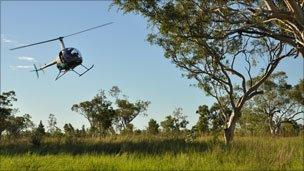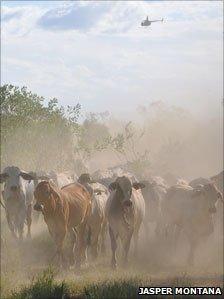Helicopter cowboys of Australia's Outback
- Published
Once round-ups on Ben Tapp's vast cattle station in northern Australia took a month. Now he can bring in 2,000 cows in five days, using low-flying helicopters.
Ben Tapp flies a helicopter like a cowboy rides a bunking bronco.
The cattleman owns two vast stations - the Australian term for ranch - deep in the Northern Territory. Maryfield Station alone covers 1,500 square km (370,000 acres) and holds some 20,000 cattle.
His livestock spreads far and wide to graze and to fatten up for the lucrative beef export markets of Asia. So when the time comes to round up the herd, Tapp takes to the skies in his red R22 helicopter.
Filmed for the BBC's Human Planet, Tapp and a fellow heli-musterer work in tandem, dipping and diving to drive the cattle home again. They are continually in what pilots call the "dead man's zone" - flying low, and flying slow.
"Generally if you're flying at 500ft-plus (153m), you've got a good chance of being able to auto-rotate out of any difficulty. If you have air speed of 70 nautical miles, you've also got a fairly good chance.
"But we fly under 300 feet (91m), and can go down to 30 knots (34mph). If your engine fails, you don't have any time to react. You just fall on to the ground."

The musterers fly below the treetops
But getting nose-to-nose with stragglers is part of the job of a cowboy, whether on a horse, a quad bike or in a helicopter.
"[Cows] go the opposite way to where you are. To guide them, you've got to get right down at times, and they're in amongst the trees," says Tapp. "It's getting low, and in amongst the trees, that enhances the danger."
Using small, manoeuvrable helicopters for the muster is now commonplace on the vast stations across Australia that hold a total of 30 million cattle. Each year, 10 helicopter musterers die in crashes. One of those who perished last year was one of Tapp's employees. Risking death or injury is an occupational hazard, he says, and he has the insurance premiums to prove it.
"It's the highest risk factor that you can get yourself insured for in the world. I insure myself for $2.5m and it costs me $42,000 a year."

Tapp's cattle are destined for Asia
About 8km out, the helicopter musterers are joined by the ground crew on quad bikes and horses for the final stretch, with Tapp directing operations by radio from above.
Tapp has been helicopter mustering for 22 years, and knows his machine, his cattle and his terrain like the back of his hand. So efficient is this method that he now has time for contract mustering on other stations.
To become a helicopter musterer, pilots need 150 hours of low flying in addition to the 110 hours for a standard licence.
"But you don't really become good at it until you've done about 1,500 hours. You've got to have the knowledge of the cattle, to anticipate where they might play up and give you trouble, to know what sort of move will be able to turn them."
It's not a job for the faint-hearted, he says.
"Most pilots are a bit cocky, but you've got to have a lot of confidence in yourself. There's cattlemanship involved too. When you set out to get 1,500 head of cattle, you want to turn up with 1,490. It's an art. It's flying and cattlemanship combined."
Human Planet will be broadcast on Thursday 17 February at 2000 GMT on BBC One, and will also be available on the BBC iPlayer.